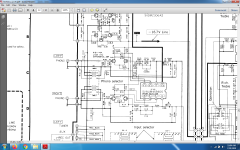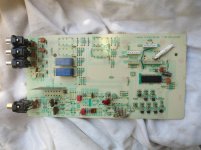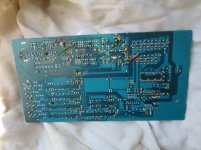It is again about overall design. However, if under same conditions FETs are 3 orders of magnitude less sensitive to RFI than BJTs, I have no reason to prefer BJTs especially on the position like the input of the phono preamp. BJTs have no single advantage here.
dreamth, you are not bringing a single engineering point, so I am not taking your posts into account.
dreamth, you are not bringing a single engineering point, so I am not taking your posts into account.
I don't think Pavel writes BJT's of. He just gave his rationale why he has chosen JFET's and not BJT's.JFET’s are better for RFI, but my point is you can take measures to ameliorate the problem with bipolars - no need to write them off.
For MM input the choice of JFET's is quite straightforward, not that much reasons to use BJT's and trying to ameliorate the issues coming with them for this kind of application.
The square - law induced distortion of FET's cancel out nicely due to the complementary and balanced input.
dreamth, you are not bringing a single engineering point, so I am not taking your posts into account.
Please clam down, PMA. He is technician, not engineer.
I rely on true engineers that already knoked you down several times, but fact is that you refuse to accept that and rely on attacking weaker's chain links .That won't make yourself any favor...You need to beat the head of the pack if you want to be recognised the alpha male, and i'm not that one !dreamth, you are not bringing a single engineering point, so I am not taking your posts into account.
dreamth, you are not bringing a single engineering point, so I am not taking your posts into account.
It's the best way!
🙂I have Picked up am radio stations on fet input phono in fairly remote areas so it can still happen. It was also atmospheric bounce and not even local so rather low frequency. NYC can be especially bad if across from the antenna in a penthouse.
Ferrite beads fixed it up.
Now that I know they sound bad I better remove them from all our Stereophile class a rated products.😀
let's just give PMA a break by rebuilding his self esteem with a real world circuit versus the " standard marantz engineered design" .Marantz PM62 schematic has some input ferrite beads too, but the circuit is actually a clone of technics Technics SU-V6 which is using no ferrite bead .Marantz is not using them either in the real circuit depending on the country version because some countries are more strict on emi than others...my uk version of PM62 was using some shunts instead of the coils, but that doesn't mean anything as 2sk369 has already 75pf input capacitance by itself and aditional capacitance at the input is added physically too and some shielding ...
Attachments
This might very well be the case, but I just wonder why I have never heard this argument before for this sort of applications.
I have seen a couple of people mention that LM4562 can pick up DECT phone transmissions very easily but not worked out if this is due to input technology, or something internal.
I still remember you claim that a digital phono eq was showed and demonstrated at AES which, after being a true inquisitor to find the true source of your information, i found that it was actually not a real piece of hardware, but a cartridge connected to an adc and connected again to a real computer running advanced algorithms to do it...Well..i couldn't source this information from AES site either... many of your claims are biased and true blunt lies too so you know my opinion on you too 🙂It's the best way!
And i forgot to mention that, the Marantz pm 62, even after being modified back to standard Technics version couldn't deal with dust at 33rpm in no way with shure v15 type 3 and D75(yes..i used them both on Dual CS-701 and Sanyo Plus Q-50 ...hopefully low noise enough turntables for your audiophile taste )Supplied at +-18v, Marantz behavior on dusty records compared to my aiwa bipolar preamp supplied at only +-15v is not even worh mentioning its quality . I simply stripped the circuit taking all the components for other projects cause my "technician" background couldn't cope with it... A phono preamp needs a lot more attention than just for SNR to be a good one.Ask J L Hood if you can't believe me.. unless his liniac SNR give you some weird allergies.
Attachments
I have seen a couple of people mention that LM4562 can pick up DECT phone transmissions very easily but not worked out if this is due to input technology, or something internal.
Hi Bill,
Never too old to learn, this was something that I never came across before, but there seems to be a real advantage for the Fet.
So the Opa1642 that I favoured is at least not a bad choice at all.
Anyhow, the LM4562 has too much current noise for a low noise MM preamp, so this is not the preferred opamp for the purpose.
I wonder how and if this Fet advantage for MM also applied for an MC preamp, or are they only advantageous for high impedance applications ?
Hans
Aha found a good source of data (from Pavel ) on ASR Sensitivity of opamps to air coupled EM fields, especially of the LM4562/LME497X0 family | Audio Science Review (ASR) Forum
DECT is one of the last users of TDMA. We all remember GSM phones negotiating a channel where you would hear the 216.6Hz frame rate until power control cut in.
DECT is one of the last users of TDMA. We all remember GSM phones negotiating a channel where you would hear the 216.6Hz frame rate until power control cut in.
I would think that for MC the current noise issue is simply not relevant, and therefore you can use BJT input with high collector currents, making the whole issue less important.[...]I wonder how and if this Fet advantage for MM also applied for an MC preamp, or are they only advantageous for high impedance applications ?
However, paralleled low noise JFets work great too in MC pre's, albeit not if you're after the world record in low noise.
So that would mean that the amount of advantage depends just on the product current noise times source resistance ??
Hans
Hans
I prefer paralleled JFET inputs for MC phono stages, largely due to the RFI rectification immunity and lack of input currents.
Adding source resistors to a BJT input stage can make it less RFI-sensitive, but doing so increases the noise, which is self-defeating.
jcarr
Adding source resistors to a BJT input stage can make it less RFI-sensitive, but doing so increases the noise, which is self-defeating.
jcarr
opa1652 is somewhat better at handling output currnts as it has a thermal pad so lower noise feedback network is possible ,just max +_18v supply rails, some parameters are lower than opa1642, some are slightly better...Hi Bill,
So the Opa1642 that I favoured is at least not a bad choice at all.
Hans
There’s some LM4562 stuff out there. It seems there is a general problem with noise - see the comments section on the TI website For example.
I’ve personally never had a problem of any description with the 4562 in line level applications but I ALWAYS include some sort of LP filtering on my designs whatever the amplifying device. On Phono, an LM4562 does not cut it noise wise. Better to stick with a 5534A.
I’ve personally never had a problem of any description with the 4562 in line level applications but I ALWAYS include some sort of LP filtering on my designs whatever the amplifying device. On Phono, an LM4562 does not cut it noise wise. Better to stick with a 5534A.
Yo will need a lot of JFET’s to beat a Zetex 851/951 MC amp for noise. See the MC Head Amp thread on this forum for example.
😉
😉
I just would like to have some recipe to tell me when to use a BJT or a FET.
It can't simply be that a Fet is always better in all situations apart from the fact how much better.
But it's an interesting discussion so far.
Hans
It can't simply be that a Fet is always better in all situations apart from the fact how much better.
But it's an interesting discussion so far.
Hans
ztx1051, ztx1055 and ztx1151 are better with higher hfe, but these are very high currents switching transistors and i'm not sure that their hfe is high enough at usual mc cartridge currents.
Last edited:
So the Opa1642 that I favoured is at least not a bad choice at all.
I hope so for when I finally test my Aurak boards 🙂
- Home
- Source & Line
- Analogue Source
- JFET input phono preamp for MM




